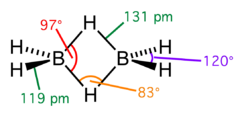
Diborane

Diborane(6), generally known as diborane is the chemical compound consisting of boron and hydrogen with the formula B2H6. It is a colorless, pyrophoric gas with a repulsively sweet odor. Synonyms include boroethane, boron hydride, and diboron hexahydride. Diborane is a key boron compound with a variety of applications. It has attracted wide attention for its electronic structure. Its derivatives are useful reagents. Diborane(6), generally known as diborane is the chemical compound consisting of boron and hydrogen with the formula B2H6. It is a colorless, pyrophoric gas with a repulsively sweet odor. Synonyms include boroethane, boron hydride, and diboron hexahydride. Diborane is a key boron compound with a variety of applications. It has attracted wide attention for its electronic structure. Its derivatives are useful reagents. Diborane adopts a D2h structure containing four terminal and two bridging hydrogen atoms. The model determined by molecular orbital theory indicates that the bonds between boron and the terminal hydrogen atoms are conventional 2-center, 2-electron covalent bonds. The bonding between the boron atoms and the bridging hydrogen atoms is, however, different from that in molecules such as hydrocarbons. Having used two electrons in bonding to the terminal hydrogen atoms, each boron has one valence electron remaining for additional bonding. The bridging hydrogen atoms provide one electron each. Thus the B2H2 ring is held together by four electrons, an example of 3-center 2-electron bonding. This type of bond is sometimes called a 'banana bond'. The lengths of the B-Hbridge bonds and the B-Hterminal bonds are 1.33 and 1.19 Å respectively, and this difference in the lengths of these bonds reflects the difference in their strengths, the B-Hbridge bonds being relatively weaker. The weakness of the B-Hbridge vs B-Hterminal bonds is indicated by their vibrational signatures in the infrared spectrum, being ≈2100 and 2500 cm−1, respectively. The structure is isoelectronic with C2H62+, which would arise from the diprotonation of the planar molecule ethene. Diborane is one of many compounds with such unusual bonding. Of the other elements in Group IIIA, gallium is known to form a similar compound, digallane, Ga2H6. Aluminium forms a polymeric hydride, (AlH3)n, although unstable Al2H6 has been isolated in solid hydrogen and is isostructural with diborane. Extensive studies of diborane have led to the development of multiple syntheses. Most preparations entail reactions of hydride donors with boron halides or alkoxides. The industrial synthesis of diborane involves the reduction of BF3 by sodium hydride, lithium hydride or lithium aluminium hydride: Two laboratory methods start from boron trichloride with lithium aluminium hydride or from boron trifluoride ether solution with sodium borohydride. Both methods result in as much as 30% yield: Older methods entail the direct reaction of borohydride salts with a non-oxidizing acid, such as phosphoric acid or dilute sulfuric acid. Similarly, oxidation of borohydride salts has been demonstrated and remains convenient for small scale preparations. For example, using iodine as an oxidizer: Another small-scale synthesis uses potassium hydroborate and phosphoric acid as starting materials. Diborane is a highly reactive and versatile reagent that has numerous applications. Its dominating reaction pattern involves formation of adducts with Lewis bases. Often such initial adducts proceed rapidly to give other products. It reacts with ammonia to form the diammoniate of diborane, DADB, with lesser quantities of ammonia borane depending on the conditions used. Diborane also reacts readily with alkynes to form substituted alkene products which will readily undergo further addition reactions.
